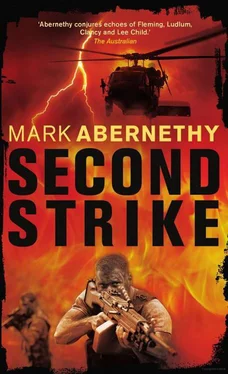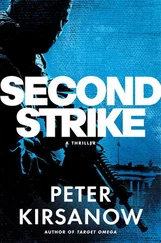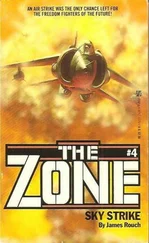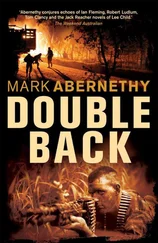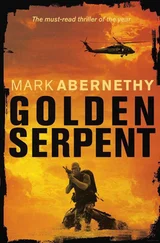Mark Abernethy - Second Strike
Здесь есть возможность читать онлайн «Mark Abernethy - Second Strike» весь текст электронной книги совершенно бесплатно (целиком полную версию без сокращений). В некоторых случаях можно слушать аудио, скачать через торрент в формате fb2 и присутствует краткое содержание. Жанр: Триллер, на английском языке. Описание произведения, (предисловие) а так же отзывы посетителей доступны на портале библиотеки ЛибКат.
- Название:Second Strike
- Автор:
- Жанр:
- Год:неизвестен
- ISBN:нет данных
- Рейтинг книги:4 / 5. Голосов: 1
-
Избранное:Добавить в избранное
- Отзывы:
-
Ваша оценка:
- 80
- 1
- 2
- 3
- 4
- 5
Second Strike: краткое содержание, описание и аннотация
Предлагаем к чтению аннотацию, описание, краткое содержание или предисловие (зависит от того, что написал сам автор книги «Second Strike»). Если вы не нашли необходимую информацию о книге — напишите в комментариях, мы постараемся отыскать её.
Second Strike — читать онлайн бесплатно полную книгу (весь текст) целиком
Ниже представлен текст книги, разбитый по страницам. Система сохранения места последней прочитанной страницы, позволяет с удобством читать онлайн бесплатно книгу «Second Strike», без необходимости каждый раз заново искать на чём Вы остановились. Поставьте закладку, и сможете в любой момент перейти на страницу, на которой закончили чтение.
Интервал:
Закладка:
Her expression eased, the hardness draining from her eyes. She looked at her feet, mouthed the words thank you and moved towards the door.
The fi rst thing Mac got from the Grant iDisk was Naveed’s name: Syed Ali Naveed, better known as S.A. Naveed.
Then he found a fax that Alex Grant had scanned into a PDF. It named Naveed’s organisation as Ocean Technologies Company, which had a Kuala Lumpur address. The fax referred to agreements and verifi ed the meeting in Jakarta on 13 December 2008. A Saturday
– today: the lunch meeting that was making Grant and Vitogiannis so antsy.
The top of the scanned document caught Mac’s attention. It was a fax number, stamped along with the date. Squinting at it, he deciphered the prefi x numbers, +971 4: Naveed was sending his faxes from the United Arab Emirates, Dubai to be exact. There was something else beside the number, but the scanning to PDF had taken defi nition out of it. Enlarging the document, the fax stamp came alive.
It said Gulf Precision Metals.
He gulped. Gulf Precision Metals was one of the front companies under the umbrella of Gulf Technical Industries, a Dubai company used right up till 2004 to ship electrical cabinets and voltage regulators from Turkey, hi-tech furnaces from Italy, vacuums from Germany, but particularly P-2 centrifuges, uranium hexafl uoride and other enrichment technologies from Pakistan. Their ultimate destination?
Libya, Iran and North Korea, to help create clandestine nuclear weapons programs for those countries.
Gulf Technical Industries was used by Dr A.Q. Khan to run his network of illicit uranium-enrichment technologies. Khan’s government-funded organisation, KRL, made the centrifuges that enriched uranium to weapons-grade. Khan sold the centrifuges, thousands at a time, to places like Iraq and Libya, and Khan had even sold the stolen plans of a Chinese nuclear bomb to North Korea.
Mac rocked back in his seat, a little freaked. The scariest thing about the A.Q. Khan network was the support it had received not only from the Pakistani military and intelligence apparatus, but also from the United States. Even after the 9-11 massacre in 2001 and the Bali bombings a year later, the US State Department had refused to issue sanctions against the Pakistanis for the illegal nuclear trade. When American spy satellites had discovered Pakistani planes loading missile components into cargo planes outside Pyongyang – widely thought to be in exchange for their latest shipment of Pakistani enrichment centrifuges – the US administration had refused to act.
By December 2001, while the World Trade Center was still cooling, Khan’s business partner, B.S.A. Tahir, signed an order from Malaysian company SCOPE for $13 million worth of aluminium centrifuge components. Hidden as oil and gas drilling parts, they were shipped to Dubai and then to Libya via the various mini-fronts under Gulf Technical Industries, of which Gulf Precision Metals was one.
Moving down Grant’s documents, Mac found one fi lled with Track Changes. It was the acquisition manifest and sale document for Bennelong’s sale of the naval C and C systems and the Type-3 enrichment algorithms not to NIME, but a Dubai company called Desert Enterprises. The manifest had all the technology in it and the fi nal sale document increased the price from US$8 million to US$60 million, provided Bennelong sold the whole parcel to Desert Enterprises.
The sale document mentioned today’s ‘physical handover’.
Grant and Vitogiannis had folded immediately when faced with so much money. This wasn’t a joint venture spin-off, it was a buy-out of enrichment algorithms, probably signed off hours ago. Mac assumed the enrichment code was now gone – probably burned on CD – and it would become an international tracking exercise to see where it ended up. It was one thing to have the centrifuges for uranium enrichment, but it was the computer systems that ran the ‘cascades’ of centrifuges. The cascades in Libya and Iran had ten thousand centrifuges operating in union and you needed serious systems to make them work properly. The Pakistanis had just bought such a system, from Australia. It made Mac sick.
There was too much in the iDisk for Mac to investigate on his own but he knew who would make sense of it, so he plugged in a USB hard drive and downloaded all of the relevant folders straight into it.
After closing the iDisk Utility, Mac entered the ASIS intranet to send a secure email to Davidson. He was fairly confi dent of its security
– Australia had led the world into government PKI, or public key infrastructure, which essentially created concentric bands of access to departmental information via websites. The ASIS one required two layers of ID, the fi rst of which was as long as a credit card number.
He made the message short: told Davidson that the company behind NIME was Malaysia-based Ocean Technologies Company, and the principal was Syed Ali Naveed, who appeared to be operating from two A.Q. Khan front companies in Dubai: Desert Enterprises and Gulf Precision Metals. He noted that the concerns shown in Canberra about what was happening to Bennelong Systems’ Type-3 enrichment algorithms was probably correct because it was highly likely their sale had been fi nalised earlier that afternoon at the Shangri-La Hotel. Mac concluded with a note about how to get into the Grant iDisk and sent it, then got on the phone to get more info on Naveed from Davidson.
The call rang out and Mac left a voicemail message telling Davidson to check his email. Trying another number, Mac got through to an ASIS landline in Perth that was answered, ‘Good afternoon, Albany Trading Asia – how may I help you?’ and asked for Davidson by his cover name. Davidson wasn’t in his corporate offi ce, so Mac left a voicemail message there too.
Stowing his laptop in his backpack, Mac left the room. With Davidson not responding, he was getting into the paranoia zone and he wanted to fi nd Freddi Gardjito and run the Naveed name by him.
Mac would bet Sydney to a six-pack that the name Hassan Ali was on Naveed’s list of known associates.
He made for the elevator bank but changed his mind at the last minute, and went for the fi re stairs. As he bounded down two at a time, he wasn’t thinking about Alex Grant or Michael Vitogiannis or NIME. He was thinking about old scores and new information, a boy stolen, a girl shot and left for dead. He was thinking about Sumatra
‘02, about Hassan Ali and Gorilla, and how Naveed was going to lead him to them.
CHAPTER 34
The lobby was quiet as Mac came around from the side and cased it for eyes, his instincts on full alert. The Naveed-Khan connections had spooked him. What had started as Mac’s return to the game in an economic team was spiralling upwards.
Fronting the desk, Mac asked for Freddi. The girl said she’d never heard of the bloke, so Mac started talking loudly about the intelligence guy from BAIS. Freddi still didn’t appear, so Mac assumed he was in one of the plenary sessions, checking out who was fl irting on the edges of Indonesia’s burgeoning public infrastructure scene.
‘Look,’ said Mac. ‘Can you tell him that Richard Davis, from room nine-oh-two, needs to talk to him urgently, but I’ve had to duck out for a couple of hours?’ he said, handing over his card.
The girl typed a message into the system, then looked up, perplexed. ‘The room service you order just going up, Mr Richard.’
‘Must be a different guy,’ said Mac, preoccupied.
The girl looked at the screen, then called something over her shoulder. The male desk guy moved beside her and looked at the screen. ‘Yes, Mr Davis,’ he said. ‘I just saw the room service porter and I ask him and he say he going to room nine-oh-two – Davis.’
Читать дальшеИнтервал:
Закладка:
Похожие книги на «Second Strike»
Представляем Вашему вниманию похожие книги на «Second Strike» списком для выбора. Мы отобрали схожую по названию и смыслу литературу в надежде предоставить читателям больше вариантов отыскать новые, интересные, ещё непрочитанные произведения.
Обсуждение, отзывы о книге «Second Strike» и просто собственные мнения читателей. Оставьте ваши комментарии, напишите, что Вы думаете о произведении, его смысле или главных героях. Укажите что конкретно понравилось, а что нет, и почему Вы так считаете.
